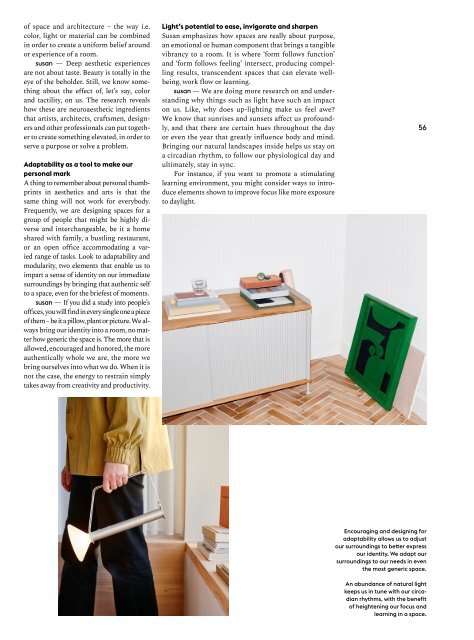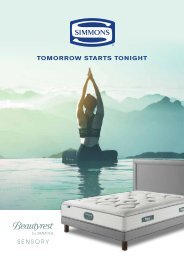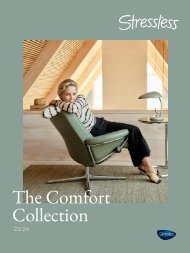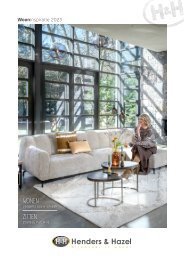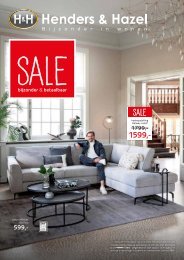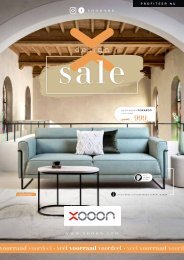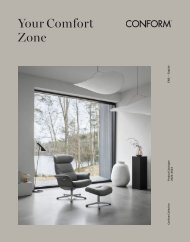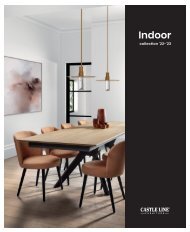Muuto_Catalog_2022
Create successful ePaper yourself
Turn your PDF publications into a flip-book with our unique Google optimized e-Paper software.
of space and architecture – the way i.e.<br />
color, light or material can be combined<br />
in order to create a uniform belief around<br />
or experience of a room.<br />
susan — Deep aesthetic experiences<br />
are not about taste. Beauty is totally in the<br />
eye of the beholder. Still, we know something<br />
about the effect of, let’s say, color<br />
and tactility, on us. The research reveals<br />
how these are neuroaesthetic ingredients<br />
that artists, architects, craftsmen, designers<br />
and other professionals can put together<br />
to create something elevated, in order to<br />
serve a purpose or solve a problem.<br />
Adaptability as a tool to make our<br />
personal mark<br />
A thing to remember about personal thumbprints<br />
in aesthetics and arts is that the<br />
same thing will not work for everybody.<br />
Frequently, we are designing spaces for a<br />
group of people that might be highly diverse<br />
and interchangeable, be it a home<br />
shared with family, a bustling restaurant,<br />
or an open office accommodating a varied<br />
range of tasks. Look to adaptability and<br />
modularity, two elements that enable us to<br />
impart a sense of identity on our immediate<br />
surroundings by bringing that authentic self<br />
to a space, even for the briefest of moments.<br />
susan — If you did a study into people’s<br />
offices, you will find in every single one a piece<br />
of them – be it a pillow, plant or picture. We always<br />
bring our identity into a room, no matter<br />
how generic the space is. The more that is<br />
allowed, encouraged and honored, the more<br />
authentically whole we are, the more we<br />
bring ourselves into what we do. When it is<br />
not the case, the energy to restrain simply<br />
takes away from creativity and productivity.<br />
Light’s potential to ease, invigorate and sharpen<br />
Susan emphasizes how spaces are really about purpose,<br />
an emotional or human component that brings a tangible<br />
vibrancy to a room. It is where ‘form follows function’<br />
and ‘form follows feeling’ intersect, producing compelling<br />
results, transcendent spaces that can elevate wellbeing,<br />
work flow or learning.<br />
susan — We are doing more research on and understanding<br />
why things such as light have such an impact<br />
on us. Like, why does up-lighting make us feel awe?<br />
We know that sunrises and sunsets affect us profoundly,<br />
and that there are certain hues throughout the day<br />
or even the year that greatly influence body and mind.<br />
Bringing our natural landscapes inside helps us stay on<br />
a circadian rhythm, to follow our physiological day and<br />
ultimately, stay in sync.<br />
For instance, if you want to promote a stimulating<br />
learning environment, you might consider ways to introduce<br />
elements shown to improve focus like more exposure<br />
to daylight.<br />
56<br />
Encouraging and designing for<br />
adaptability allows us to adjust<br />
our surroundings to better express<br />
our identity. We adapt our<br />
surroundings to our needs in even<br />
the most generic space.<br />
An abundance of natural light<br />
keeps us in tune with our circadian<br />
rhythms, with the benefit<br />
of heightening our focus and<br />
learning in a space.


